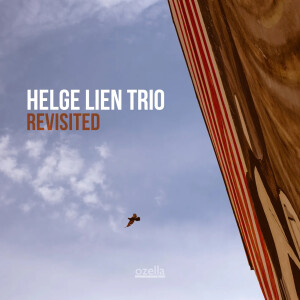 Norwegian pianist Helge Lien’s jazz trio has undergone major changes in the past couple of years, losing bassist Frode Berg after 2017’s superb Guzuguzu and drummer Per Oddvar Johansen (after 2019’s 10). So Lien found himself improvising even more than usual, re-thinking and re-assembling his trio during the pandemic, while continuing to record and perform (virtually). The rebuilt trio includes bassist Johannes Eick, who has played with numerous individuals and groups including Christian Wallumrød, Per Oddvar Johansen, Trygve Seim and Rob Waring, and the Helge Lien Trio’s original drummer Knut Aalefjær behind the kit.
Norwegian pianist Helge Lien’s jazz trio has undergone major changes in the past couple of years, losing bassist Frode Berg after 2017’s superb Guzuguzu and drummer Per Oddvar Johansen (after 2019’s 10). So Lien found himself improvising even more than usual, re-thinking and re-assembling his trio during the pandemic, while continuing to record and perform (virtually). The rebuilt trio includes bassist Johannes Eick, who has played with numerous individuals and groups including Christian Wallumrød, Per Oddvar Johansen, Trygve Seim and Rob Waring, and the Helge Lien Trio’s original drummer Knut Aalefjær behind the kit.
As this new trio rehearsed it arrived at its own interpretations of Lien’s songs new and old, all the way back to 2002’s What Are You Doing the Rest of Your Life. The natural next step was to revisit some of the repertoire. This album Revisited was partly recorded in intimate “studio” sessions at the Toyen church in Oslo, and partly live in front of an audience at the Anjazz Festival in October 2020, although there’s no indication which were which, as there’s no crowd noise from the live tracks.
What’s it like? Let’s just say I’ve found the first few entries for my 2022 favorite jazz tracks playlist!
I think of the Helge Lien Trio as players of a subdued kind of Nordic modern jazz, all tension and release, but of course that’s not true; or at least an oversimplification. But this album starts with three tunes on the quieter end of the spectrum. “Hymne Revisited” (from Natsukashii, 2011) is a blue meditation that’s a good introduction to the trio’s more pensive terrain; “Liten Jazzballong Revisited” (Spiral Circle, 2002) has a sweet and slow piano melody that could pass for smooth jazz if not for the subtly intense drum and bass that belie what’s coming off the keyboard; and “Spiral Circle Revisited” (Asymmetrics, 2003) is sweetly meditative, melodic and mellow, with an lusciously melancholy bass solo from Eick. At least in its initial melody, it sounds more hymnlike to me than “Hymne.”
After that mellow introduction we get four that are melodic, upbeat, rhythmic, starting with “Gamut Warning Revisited.” This revisitation has a punch that wasn’t there in the original version recorded for their breakthrough album, 2008’s Hello Troll. They’ve picked up the pace and Lien occasionally smothers the left-hand strings with his right for a slight prepared sound. This one has a very fun intro in which piano and bass play the melody in marvelous synch. Then throughout the song the connection between bass and drums is marvelous, as they dance around the central theme as Lien improvises languidly at first, then with increasing urgency. This one definitely goes on the 2022 favorite jazz tracks playlist.
“Meles Meles” is a lush and lovely ballad on which Aalefjær and Eick complement each other beautifully on drums and bass. There’s a sublime section in which the bass takes melody, the bow highlighting the melancholy tune, and the drums’ ride cymbal work setting up a crisp contrast.
The sprightly “Folkmost” was one of my favorite tunes on 2014’s Badgers and Other Beings, which was my introduction to Lien. It has “folk” in the title but this revisited version brings a little rock too, as Lien swings wildly from melodic runs to strident block chords and back. But basically it’s sunny contemporary piano jazz with just enough unexpected chordal excursions to keep it very interesting. “Jasmine” was a standout track on 2017’s Guzuguzu, one of the more melodic offerings on what was a pretty experimental album – it was also the only track whose title was not a bit of Japanese onomatopoeia. This time out it opens with a portentous bass solo, then settles into a stately melodic groove. Lien pushes the harmonic envelope a bit as Aalefjær beats out a slightly martial tattoo on the toms; the portentous bass and toms underlying the melody eventually devolves into a drawn out anxiety invoking section, which resolves back to the original somber but uplifting melody. These tunes all bear repeated listening, but “Jasmine” perhaps most of all.
The two closing tracks both are drawn from the trio’s most recent release 10. Aalefjær starts “Krystall”
with an extended, hushed snare solo played with a combination of brush and hand. This is a subtle piece all around; all of Lien’s best work focuses as much on texture and color as on rhythm and melody, and that’s very evident in these final two pieces quite a bit. “Nipa Revisited” wraps things up in a lovely way with its folksy tune and rather uplifting waltz time. Lien’s melodic explorations are played out over lots of long whole notes on bass that contrast with skittery brushed snares.
I like the way Ozella’s publicity for this album sums it up:
Whereas, more than a decade ago, he would radically deconstruct a piece like Miles Davis’s “So What,” his focus has shifted towards a dense, precisely synchronized group sound and hypnotic, quicksilvery piano runs. There is still no safety net, however. The art of improvisation always takes place at the edge of failure – no one knows this better than Helge Lien.
There was never really any doubt in my mind that Helge Lien Trio continued to have a bright future with whatever lineup. This is a very good album for many reasons, especially to have these fresh and vibrant versions of songs from Lien’s back catalog.
(Ozella, 2022)
